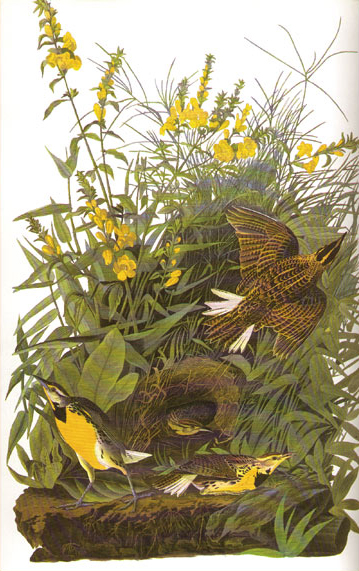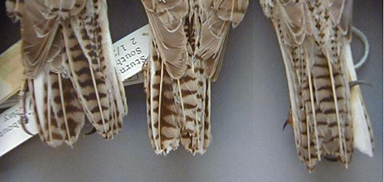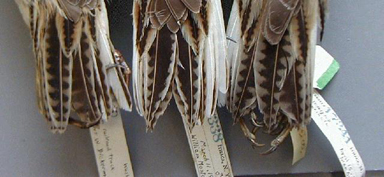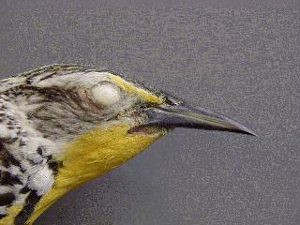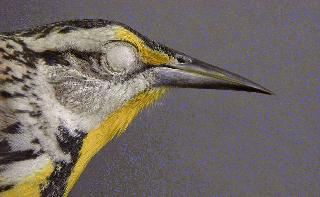Lewis’s Specimen
One thing was foremost in Meriwether Lewis‘s mind that Saturday morning in June 1805, on the Corps’ first tough trip from Portage Creek across the cactus-paved prairie to White Bear Islands. At long last he was going to begin assembling “the experiment”—the iron boat. Nevertheless, when his ear was seared by the fanfare of a familiar-looking bird, he killed a specimen and took time out to study it up close, and make a few notes.[1]The “croop,” properly crop, is the pouch in a bird’s throat where food is partially digested, or is stored for regurgitation to nestlings. “There is a kind of larke here,” he wrote,
that much resembles the bird called the oldfield[2]The once-common term oldfield referred to land exhausted of nutrients by unvaried use for single crops, and allowed to lie fallow. Thomas Jefferson devised a crop rotation plan to prevent that … Continue reading lark with a yellow brest and a black spot on the croop; tho’ this differs from ours in the form of the tail which is pointed, being formed of feathers of unequal length; the beak is somewhat longer and more curved and the note differs considerably; however in size, action, and colours there is no perceptable difference; or at least none that strikes my eye.
At Fort Clatsop the following March, he mentioned it briefly in a summary of birds they had seen to date: “The lark is found in the plains only and are the same with those before mentioned on the Missouri, and not very unlike what is called in Virginia the old field lark.“
He was correct, for the two birds are almost indistinguishable. In the Mississippi valley, where their ranges overlap, they actually interbreed, and some males even sing the songs of both species.[3]Paul R. Ehrlich, David S. Dobkin, and Darryl Wheye, The Birder’s Handbook: A Field Guide to the Natural History of North American Birds (New York: Simon & Schuster, Inc., 1988), 608, 610. They’re easier to spot today than they would have been in Lewis’s day, for in spring they’re most often seen singing from atop those handy modern conveniences, fence posts.
Meriwether Lewis, wrote Jefferson in a letter to Dr. Benjamin Rush in February of 1803, “is not regularly educated, but he possesses a great mass of accurate observation on all the subjects of nature which present themselves here, & will therefore readily select those only in his new route which shall be new.”[4]Donald Jackson, ed., Letters of the Lewis and Clark Expedition, with Related Documents, 1783-1854 (2nd ed., Urbana: University of Illinois Press, 1978), 18-19. That Lewis could make comparisons of those three details—the tail feathers, the beaks, and the “note”—is ample evidence of the accuracy of the President’s assessment of his qualifications.
Eastern v. Western
Neither kind is claimed by the European Aulaudidae (ah-LAW-di-die; Latin for lark) family, which includes the horned lark, and the skylark of poetic fame.[5]The skylark, Alauda arvensis (ah-LAW-dah, “lark”; ar-VEN-sis, “field”) was introduced on Vancouver Island, British Columbia, about 1902. The North American meadowlarks are the sole members of a genus named Sturnella (stir-NEL-ah), which is Latin for “starling-like.” In springtime they meet their mates, and during the summer build their nests in meadowlands and cultivated fields throughout the middle latitudes. Back East, the expression “old field” denoted land exhausted by cultivation and no longer worth tilling, and thus made ideal nurseries for the species.[6]George Davis McJimsey, Topographic Terms in Virginia (New York: Columbia University Press, 1940), 98.
In the fall, easterners fly to Central America and Brazil, and westerners to Mexico, where they pass the time in flocks of as many as 100 birds. That qualifies their genus for membership in the avian family named Troupial—(TROO-pee-al), Latin for troupe, or flock. Among the meadowlarks’ cousins, with similar seasonal proclivities for mob scenes, are blackbirds, orioles, grackles, and cowbirds.[7]But not starlings, which comprise a large family of their own, the Sturnidae, containing 111 species worldwide. The familiar Sturnus vulgaris, or common starling, was introduced to the U.S. in the … Continue reading The eastern meadowlark is now officially known as Sturnella magna (MAG-na; large), although it is about equal in size to its neighbor “standing eight inches tall, measuring eight to eleven inches from beak-tip to tail-tip, and having a wingspan of from thirteen to seventeen inches.” The one Lewis found in the West languished nameless until John James Audubon dubbed it neglecta (nee-GLEK-tah; Latin for neglected) because, he wrote in 1840, although “the existence of this species was known to the celebrated explorers of the west, Lewis and Clark, . . . no one has since taken the least notice of it.” The two are generally of equal size.
Unapologetically, Audubon concluded his description with the remark that its flesh resembles that of the eastern species, “and is indifferent eating.”[8]John James Audubon, The Birds of America, in Audubon’s Multimedia Birds of America, http://www.abirdshome.com/Audubon/VolVII/00799.html. If that sounds bizarre, or even heartless, it should be recalled that by the end of the nineteenth century some of our forebears had eaten the beautiful—and correspondingly delicious—passenger pigeon into extinction.[9]Lewis and Reubin Field lunched on a few passenger pigeons at Camp Disappointment on 25 July 1806.
Different Notes
Western Meadowlark Song
Recorded by Richard Kuschel.
The counterpoint of melodies in this morning sing-along features backup tunes from a Clark’s nutcracker, a magpie, a Montana horned owl, and an anonymous warbler or two.
O lovely, lovely, chanting arrow Lark,
Sprung like an arrow from the bow of dark,
O Lark, arise!
Sing the dayrise, the great dayrise!
—Genevieve Taggard
Play Eastern Meadowlark Song
Borror Laboratory of Bioacoustics, Department of Evolution, Ecology, and Organismal Biology, Ohio State University, Columbus, Ohio. All rights reserved.
In the background, there is a mixed choir of spring-morning songsters, including blackbirds, warblers, sparrows, a raven, and a distant meadowlark replying with his own musical no-trespassing sign.
Songbirds hatch with built-in, functional calls. They use them to communicate simple signals such as alarms, which may be recognized by any other species within earshot. Contact calls serve between mates to indicate relative locations. Bird songs, which are more complex, are used in courtship, and at the same time serve as audible fences to keep rivals out of the suitor’s territory. Songs are learned by chicks over periods of weeks or months. Studies have suggested that every bird hatches with a neurological template implanted in its brain, which enables it to sort out the sounds in its environment, and learn from successful, older neighbor males the songs it needs to know.
The song of the western meadowlark Lewis studied differed considerably from that of the “old field” lark back home in Virginia. But in general, any songbird may have a repertoire of up to ten different “song types,” and there may be infinite varieties of local dialects among members of the same species. Therefore, the two meadowlark songs on these pages may only remotely sound like those of the same species in your neighborhood.
Birds do not have larynxes and vocal cords as humans do, but produce the notes of their songs by blowing air over elastic membranes in an organ called a syrinx, which is between the trachea, or windpipe, and the two bronchial tubes connected to the lungs. A bird utilizes nearly one hundred percent of its breath to produce sounds, compared with only two percent used in human speech.
Birds with complicated songs have from five to nine pairs of syringeal muscles with which they can change the tension in those membranes, like violin strings, to produce various pitches. In contrast, the monotonous pigeon has only one pair of syringeal muscles. The size of the tracheal resonator, combined with the size and capacity of the lungs, determines the loudness of a species’ song.[10]John K. Terres, ed., The Audubon Society Encyclopedia of North American Birds (New York: Wings Books, 1991), “Voice and sound-making: An illustration of a syrinx” will be found on the Web … Continue reading Meadowlarks, both eastern and western, obviously are well endowed on both counts.
A songbird’s musical career is not very long. Although the oldest known American robin lived a venerable thirteen years and eleven months, the median life expectancy of songbirds in general is between one and two years.[11]Ehrlich and others, The Birder’s Handbook, 643-647. The maximum life-span of the meadowlark is not known, but on average, both the eastern and western species are at greater-than-average risk of early death because they nest on open ground, where broods may unintentionally be destroyed by farm machinery. Today we are short on “old fields.”
Different Tails
Lewis wrote: “this differs from ours in the form of the tail which is pointed, being formed of feathers of unequal length . . . ” The greatest difference between the eastern and western meadowlark, Audubon agreed later,
is in the form of the tail, which in this [western] species is nearly square, and consequently has the feathers nearly equal, whilst in the common one [the eastern, or oldfield lark], the tail is rounded, and the two lateral feathers are nearly three quarters of an inch shorter than the middle ones; besides which, the central tail-feathers of the present [western] bird are narrowly barred, and not scalloped on their margins as in Sturnella Ludoviciana [LOO-doh-vee-cee-ANNA, of (the Territory of) Louisiana].[12]Audubon’s Multimedia Birds of America, http://www.abirdshome.com/Audubon/VolVII/00799.html
Similar Heads
The similarity between the bills on these two preserved specimens almost disaffirms Lewis’s comparison-by-recollection. He may have been right, for slight differences in color, shape and size can occur even within a species, but these two photos serve to reinforce the consensus now that the two kinds of North American meadowlark are visually almost indistinguishable:
Some ornithologists prefer to reserve the word beak to denote the mandibles—jaws—of birds of prey, such as hawks and eagles, and use for the rest the word bill. Technically, it is termed the rostrum.[13]John K. Terres, ed., The Audubon Society Encyclopedia of North American Birds (New York: Wings Books, 1991), “beak,” “bill.” In ancient times the Latin word rostrum was the … Continue reading
A bird’s bill is Nature’s most successful all-purpose tool. It serves as well for personal grooming as for expressing something like affection toward a mate. It works as a thumb-and-forefinger to pick up, carry and arrange building materials for nests. It’s a three-in-one combination of knife, fork and spoon, and doubles as both lips and teeth. It’s an effective weapon. For some birds it’s also a hammer and a chisel. Across the whole spectrum of avian anatomies, it comes in an amazing variety of sizes, shapes and colors to correspond with individual lifestyles. Some birds even wear bills of different colors to suit the season. What’s more, it’s economical! It continuously renews itself to replace a work-worn tip. Bills hold tongues too, but not many taste buds —perhaps fewer than fifty, compared with a human’s 9,000.
Notes
| ↑1 | The “croop,” properly crop, is the pouch in a bird’s throat where food is partially digested, or is stored for regurgitation to nestlings. |
|---|---|
| ↑2 | The once-common term oldfield referred to land exhausted of nutrients by unvaried use for single crops, and allowed to lie fallow. Thomas Jefferson devised a crop rotation plan to prevent that degradation and improve productivity of his farmland. George McJimsey, Topographic Terms in Virginia; American Speech, Reprints and Monographs, No. 3: Columbia University Press, 1940. Before the discovery of the benefits of natural, and later chemical, fertilizers, the descent of farmland into oldfield condition was one of the forces that continually drove North American settlers westward. |
| ↑3 | Paul R. Ehrlich, David S. Dobkin, and Darryl Wheye, The Birder’s Handbook: A Field Guide to the Natural History of North American Birds (New York: Simon & Schuster, Inc., 1988), 608, 610. |
| ↑4 | Donald Jackson, ed., Letters of the Lewis and Clark Expedition, with Related Documents, 1783-1854 (2nd ed., Urbana: University of Illinois Press, 1978), 18-19. |
| ↑5 | The skylark, Alauda arvensis (ah-LAW-dah, “lark”; ar-VEN-sis, “field”) was introduced on Vancouver Island, British Columbia, about 1902. |
| ↑6 | George Davis McJimsey, Topographic Terms in Virginia (New York: Columbia University Press, 1940), 98. |
| ↑7 | But not starlings, which comprise a large family of their own, the Sturnidae, containing 111 species worldwide. The familiar Sturnus vulgaris, or common starling, was introduced to the U.S. in the 1890s; by 1950, immigrant starlings had colonized the continent from coast to coast. |
| ↑8 | John James Audubon, The Birds of America, in Audubon’s Multimedia Birds of America, http://www.abirdshome.com/Audubon/VolVII/00799.html. |
| ↑9 | Lewis and Reubin Field lunched on a few passenger pigeons at Camp Disappointment on 25 July 1806. |
| ↑10 | John K. Terres, ed., The Audubon Society Encyclopedia of North American Birds (New York: Wings Books, 1991), “Voice and sound-making: An illustration of a syrinx” will be found on the Web at British Garden Birds, http://www.garden-birds.co.uk/information/birdsong.htm |
| ↑11 | Ehrlich and others, The Birder’s Handbook, 643-647. |
| ↑12 | Audubon’s Multimedia Birds of America, http://www.abirdshome.com/Audubon/VolVII/00799.html |
| ↑13 | John K. Terres, ed., The Audubon Society Encyclopedia of North American Birds (New York: Wings Books, 1991), “beak,” “bill.” In ancient times the Latin word rostrum was the name for the pointed prow of a warship, and in a Roman forum the speaker’s platform was typically built to represent the prow of a captured enemy galley. And so, today a rostrum can be either a speaker’s platform—usually without a pointed prow—or a bird’s bill, with. |
Experience the Lewis and Clark Trail
The Lewis and Clark Trail Experience—our sister site at lewisandclark.travel—connects the world to people and places on the Lewis and Clark Trail.
Discover More
- The Lewis and Clark Expedition: Day by Day by Gary E. Moulton (University of Nebraska Press, 2018). The story in prose, 14 May 1804–23 September 1806.
- The Lewis and Clark Journals: An American Epic of Discovery (abridged) by Gary E. Moulton (University of Nebraska Press, 2003). Selected journal excerpts, 14 May 1804–23 September 1806.
- The Lewis and Clark Journals. by Gary E. Moulton (University of Nebraska Press, 1983–2001). The complete story in 13 volumes.


